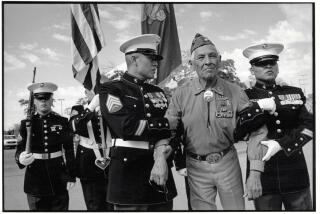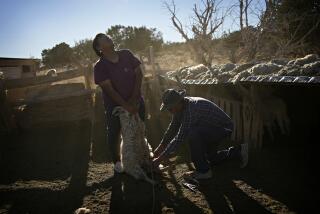SHOPPING FOR ANTIQUES : Eye-Dazzling Navajo Blankets
- Share via
SADDLE BLANKETS, serapes, chief’s blankets and hogan-entrance flaps--these woolen textiles woven by the Navajos in the 18th and 19th centuries are among the most vivid and colorful of American Southwest antiques.
From the 1690s, when Navajo women were taught the use of the upright loom by their Pueblo neighbors, to the present day, when Navajo weavers have revived old techniques to create handsome rugs and hangings, such blankets have been widely admired. They were sought after not only by Spanish, Anglo and Mexican settlers but by other tribes of Indians as well. Often, the Navajo traded with the Ute, and the standard price for a handsome chief’s blanket was $50, or five buckskins, or a dressed buffalo robe, or even a mare. A hand-woven Navajo blanket has always been a high-ticket item.
Navajo designs are striking, but the most impressive thing about the Navajo blanket has always been its brilliant use of color: black dye from pinon pitch, indigo from Mexico, red from the cochineal beetle or the unraveled threads of a commercial trade cloth called bayeta (early on, Navajo weavers unraveled the red thread from the coats of Spanish soldiers killed in Indian skirmishes). Later, the bright aniline dyes of Pennsylvania came to the Navajo via trade routes and found their way into Eye Dazzler and Germantown blankets and rugs.
Until a U.S. government internment of the entire tribe in the early 1860s, Navajo blanket designs had been primarily geometric. But as nearly three-quarters of the tribe died from starvation and contaminated water, Navajo weavers inexplicably began creating vibrant, shimmering patterns such as the Eye Dazzler, with its brilliant colors and zigzag lines.
After the Treaty of 1868 and the Long Walk back from Fort Defiance to their reservation, Navajo weavers changed directions. Traders such as Juan Lorenzo Hubbell had persuaded the Navajos to make their blankets heavier and had even supplied more “Indian-looking” designs. These “rugs” were shipped back to the East, where they became enormously popular as floor coverings and wall hangings. Many of these trader-inspired rugs have survived.
On the other hand, blankets woven before the 1860s are virtually non-existent, and what few remain are in museums. Today, old designs are faithfully reproduced at Navajo weaving centers in New Mexico such as Two Grey Hills and Burntwater, along with striking contemporary creations: ceremonial design rugs made from sand paintings and Yei-figure rugs. Indian rugs can be found in antique shops beginning at about $200; the finest examples of classic Navajo blankets are handled by dealers and might command as much as $30,000.
The gift shop in the Southwest Museum has excellent Indian textiles. Both antique and contemporary Navajo blankets and rugs can be found at Federico Antiques, Wounded Knee Gallery and Nonesuch Gallery, all in Santa Monica; the Native American Art Gallery, Venice , and the Indian Art Center, Studio City. Local antique blanket dealers include Don Bennett (818) 991-5596, and Kim Martindale (818) 889-5187.


